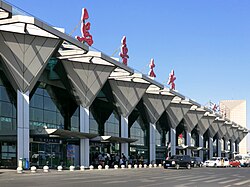Top Qs
Timeline
Chat
Perspective
Ürümqi Tianshan International Airport
Airport serving Ürümqi, Xinjiang, China From Wikipedia, the free encyclopedia
Remove ads
Ürümqi Tianshan International Airport (IATA: URC, ICAO: ZWWW) is an international airport serving Ürümqi, the capital of Northwest China‘s Xinjiang Uygur Autonomous Region.[4] It is located in the Diwopu township of Xinshi district, 16 km (9.9 mi) northwest of downtown Ürümqi. As a hub for China Southern Airlines and as a focus city for Hainan Airlines, the airport handled 23,027,788 passengers in 2018, making it the 19th busiest airport in China by passenger traffic.[5]
Remove ads
Remove ads
History
Summarize
Perspective
You can help expand this section with text translated from the corresponding article in Chinese. (July 2023) Click [show] for important translation instructions.
|
Urumqi Airport was opened to foreign passengers in 1973,[6] and has been used for emergency landings for flights between Europe and west Asia. It has been renamed from Ürümqi Diwopu International Airport to Ürümqi Tianshan International Airport in March 2025.[7][4]
Remove ads
Facilities
Summarize
Perspective
The airport covers an area of 484 hectares (1,200 acres). Its newly built runway is 3,600 m (11,800 ft) in length. The airport can allow the landing of large aircraft such as the Boeing 747. The 110,000 m2 (1,200,000 sq ft) apron can accommodate over 30 aircraft.[citation needed]
Runways
- The first runway (07/25) was built in 1994 to accept the expansion, the flight zone level 4E, runway length 3,600 meters (11,811 ft), 45 meters (148 ft) wide, PCN value of 74, elevation 648 meters, with Class II precision approach.
- The second runway (???): under construction, located to the north of the current runway, flight zone level 4F, runway length 3,600 meters (11,811 ft), 60 meters (197 ft) wide.
- The third runway (???): under construction, located to the north of the current runway, flight zone level 4F, runway 3,200 meters (10,499 ft) long, 60 meters (197 ft) wide.
Terminals
Terminal 1
The original terminal opened in 1974. It was closed between April 23, 2011, and August 30, 2013, for renovation.[8] On April 1, 2014, operations were resumed.[9] After the transformation of the T1 terminal has six security channels, 19 check-in counters, with the peak hourly 700 times the business capacity.[clarification needed][10] This terminal is mainly for regional aviation around Xinjiang province and low-cost aviation use, including Tianjin Airlines, Capital Aviation, Spring Airlines, Yunnan Xiangpeng Airlines, China United Airlines, Okay Airways, Ryanair[11] and Western Airlines.[12]
Terminal 2
Construction on this terminal started in April 1994, was completed in December 2001 through the national acceptance, and on May 12, 2002, the terminal opened. On July 10, 2010, it closed for a renovation project, and resumed operations on April 16, 2011.[13] It serves most domestic routes outside of Xinjiang province, except for China Southern, Xiamen and Chongqing Airlines flights.
Terminal 3
Construction of Terminal 3 to the west of the older terminal building began in April 2007 at a cost of 2.8 billion yuan (350 million U.S. dollars). It increased Diwopu's ability to handle more than three times its 2007 capacity of 5.13 million passengers annually to 16.35 million passengers annually. It can also handle 275,000 tons of cargo and 155,000 aircraft a year. Terminal 3 added 22 more jet bridges and nearly 106,000 square meters of new terminal space.[14] The terminal opened in 2009.
Terminal 4

An expansion project, which began in 2017, is underway and will see a new terminal building covering almost 400,000 sq meters consisting of 177 gates, as well as two additional runways north of the existing.[15][16] Originally set to open in 2024, the date was pushed backed to 17 April 2025 due to many aspects of the terminal being unfinished. After the opening of T4, the previous three terminals will be converted to cargo relay stations as part of the Belt and Road Initiative.
Remove ads
Airlines and destinations
Passenger
Cargo
Remove ads
Statistics
Graphs are unavailable due to technical issues. Updates on reimplementing the Graph extension, which will be known as the Chart extension, can be found on Phabricator or on the deployment timeline page. |
Annual passenger traffic at URC airport.
See Wikidata query.
Other facilities
When the airline existed, China Xinjiang Airlines had its headquarters on the airport property.[70]
Ground Transport
International Airport station on Line 1 of Ürümqi Metro opened on 25 October 2018 and links the airport to downtown Ürümqi. In addition, the Ürümqi International Airport MRT, or simply Airport MRT, has opened and is featuring two stations, namely International Airport and International Airport North.
See also
References
External links
Wikiwand - on
Seamless Wikipedia browsing. On steroids.
Remove ads













